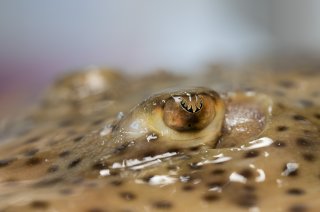
Project
Innorays: video monitoring
How can we use video monitoring ('electronic monitoring') to determine how many rays are caught?
Better catch data for rays is needed for the management of fisheries and nature
Rays are a long-lived and important species for the North Sea ecosystem. They are also a commercially interesting bycatch in flatfish fisheries. However, we know little about the total quantities of rays that are caught in the North Sea and the size of the different species of ray stocks that live in the North Sea. The advice on sustainable catch quantities from the International Council for the Exploration of the Sea (ICES) is based solely on data from surveys conducted with research vessels. As a result, the stock assessments carry great uncertainties and the catch advice is therefore extra precautionary.
- Unfortunately, your cookie settings do not allow videos to be displayed. - check your settings
What are the core questions of the research?
- How efficiently can we record rays in fish catches using electronic monitoring?
- Can we improve the data for the assessment of Thornback ray (Raja clavata) and Blond rays (Raja brachyura) in the North Sea using video images?
We answer these questions in close cooperation with our partners from the Dutch fishing industry: VisNed and Nederlandse Vissersbond. With the outcomes, we are improving the knowledge base for the management of rays. We also lay the foundation for improving the catch data in the future for other stocks that are an important commercial bycatch.
The research is part of a larger project. In addition to the use of REM systems, Wageningen University and Research, together with the fishing industry, is also investigating whether we can improve population estimates with an innovative DNA method (known as close kin mark recapture).
Video monitoring (electronic monitoring)
To gather information about the catches of Thornback ray and Blonde ray, four North Sea fishing vessels will be equipped with an electronic monitoring (EM) system in early 2019. The EM system consists of a computer, sensors and a closed circuit television system to record images of the catches. Because the EM system is permanently on board the vessel and can record continuously, we can monitor more fish catches compared to the usual observer programmes, where researchers accompany commercial vessels to register catches. Due to the high cost of this method, the current observer programme for the flatfish fleet in the Netherlands is limited to ten fishing trips per year. The increase in sampling intensity facilitated by the EM system is necessary to get a more detailed picture of the distribution of catches over time (during the year) and space (the different fishing grounds) for species that are less often caught, such as rays. Our commitment is that the EM data will make a significant contribution to the improvement of the stock assessments of rays in the North Sea.
Automatic image recognition
In collaboration with the Farm Technology group at Wageningen University and Wageningen Plant Research, we also look at the technical feasibility of automatic image recognition. Can computer programmes automatically recognize the species of ray that lie on the processing belt of the ship? This automation could result in a significant improvement in the catch registration of rays.